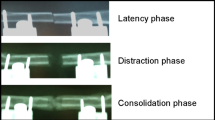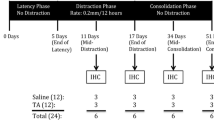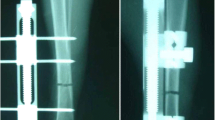Abstract
Lithium, popular in psychology field, has been recognized as an activator component of the canonical Wnt signaling pathway. The effect of lithium on osteogenesis or on the human fracture risk has been widely reported. However, little is known on its role in distraction osteogenesis to date. In this study, the effect of systematic administrated lithium on distraction osteogenesis in a rat model was investigated. The osteotomy was performed on the right tibia in 40 adult male Sprague-Dawley rats. Then they were randomly assigned into two equal groups (n = 20/group), which underwent Lithium or saline treatment through gastric gavage until the day they were killed. One week after the osteotomy, the tibias were distracted for 14 days (rate 0.6 mm/day). Following 8 weeks consolidation period, the distracted tibias in both groups were harvested and examined by X-ray plain radiography, histology, dual-energy X-ray absorptiometry, Micro-CT, and biomechanical tests. The results showed that lithium group possessed higher bone mineral density, more mature new bone tissue, and better regenerated bone mass continuity in the distraction gaps without any local or systemic adverse effects was encountered. This study suggested lithium could increase bony callus ossification volume and accelerate distracted tissue mineralization to facilitate bone regeneration in distraction gap.





Similar content being viewed by others
References
Amir LR, Everts V, Bronckers A (2009) Bone regeneration during distraction osteogenesis. Odontology 97:63–75
Davies J, Turner S, Sandy JR (1998) Distraction osteogenesis—a review. Br Dent J 185:462–467
Aronson J, Rock L (1997) Limb-lengthening, skeletal reconstruction, and bone transport with the Ilizarov method. J Bone Joint Surg Am 79A:1243–1258
Aronson J (1994) Temporal and spatial increases in blood flow during distraction osteogenesis. Clin Orthop 301:124–131
Hu J, Qi MC, Zou SJ, Li JH, Luo E (2007) Callus formation enhanced by BMP-7 ex vivo gene therapy during distraction osteogenesis in rats. J Orthop Res 25:241–251
Li G, Bouxsein ML, Luppen C, Li XJ, Wood M, Seeherman HJ, Wozney JM, Simpson H (2002) Bone consolidation is enhanced by rhBMP-2 in a rabbit model of distraction osteogenesis. J Orthop Res 20:779–788
Li G, Ryaby JT, Carney DH, Wang H (2005) Bone formation is enhanced by thrombin-related peptide TP508 during distraction osteogenesis. J Orthop Res 23:196–202
Seebach C, Skripitz R, Andreassen TT, Aspenberg P (2004) Intermittent parathyroid hormone (1-34) enhances mechanical strength and density of new bone after distraction osteogenesis in rats. J Orthop Res 22:472–478
Carney SM, Goodwin GM (2005) Lithium—a continuing story in the treatment of bipolar disorder. Acta Psychiat Scand 111:7–12
Young AH, Newham JI (2006) Lithium in maintenance therapy for bipolar disorder. J Psychopharmacol 20:17–22
Vestergaard P, Rejnmark L, Mosekilde L (2005) Reduced relative risk of fractures among users of lithium. Calcified Tissue Int 77:1–8
Wilting I, de Vries F, Thio B, Cooper C, Heerdink ER, Leutkens HGM, Nolen WA, Egberts ACG, van Staa TP (2007) Lithium use and the risk of fractures. Bone 40:1252–1258
Clement-Lacroix P, Ai MR, Morvan F, Roman-Roman S, Vayssiere B, Belleville C, Estrera K, Warman ML, Baron R, Rawadi G (2005) Lrp5-independent activation of Wnt signaling by lithium chloride increases bone formation and bone mass in mice. Proc Natl Acad Sci USA 102:17406–17411
Warden SJ, Hassett SM, Bond JL, Rydberg J, Grogg JD, Hilles EL, Bogenschutz ED, Smith HD, Fuchs RK, Bliziotes MM, Turner CH (2010) Psychotropic drugs have contrasting skeletal effects that are independent of their effects on physical activity levels. Bone 46:985–992
Zamani A, Omrani GR, Nasab MM (2009) Lithium’s effect on bone mineral density. Bone 44:331–334
Bain G, Muller T, Wang X, Papkoff J (2003) Activated beta-catenin induces osteoblast differentiation of C3H10T1/2 cells and participates in BMP2 mediated signal transduction. Biochem Biophys Res Commun 301:84–91
Kugimiya F, Kawaguchi H, Ohba S, Kawamura N, Hirata M, Chikuda H, Azuma Y, Woodgett JR, Nakamura K, Chung U (2007) GSK-3 beta controls osteogenesis through regulating Runx2 activity. PLoS One 9:e837
Chappard D, Baslé MF, Legrand E, Audran M (2011) New laboratory tools in the assessment of bone quality. Osteoporos Int 22:2225–2240
Wang JF, Chen B, Young LT (1999) Identification of a novel lithium regulated gene in rat brain. Mol Brain Res 70:66–73
Gundberg CM, Clough ME, Carpenter TO (1992) Development and validation of a radioimmunoassay for mouse osteocalcin—paradoxical response in the hyp mouse. Endocrinology 130:1909–1915
Hahn M, Vogel M, Delling G (1991) Undecalcified preparation of bone tissue—report of technical experience and development of new methods. Virchows Arch 418:1–7
Choi IH, Chung CY, Cho TJ, Yoo WJ (2002) Angiogenesis and mineralization during distraction osteogenesis. J Korean Med Sci 17:435–447
Al-Aql ZS, Alagl AS, Graves DT, Gerstenfeld LC, Einhorn TA (2008) Molecular mechanisms controlling bone formation during fracture healing and distraction osteogenesis. J Dent Res 87:107–118
Wang H, Sun W, Ma JQ, Pan YC, Wang L, Zhang WB (2014) Polycystin-1 mediates mechanical strain-induced osteoblastic mechanoresponses via potentiation of intracellular calcium and Akt/β-catenin pathway. PLoS One 9:e91730
Tang GH, Xu J, Chen RJ, Qian YF, Shen G (2011) Lithium delivery enhances bone growth during midpalatal expression. J Dent Res 90:1246–1252
Aronson J, Shen XC, Skinner RA, Hogue WR, Badger TM, Lumpkin CK (1997) Rat model of distraction osteogenesis. J Orthop Res 15:221–226
Choi IH, Ahn JH, Chung CY, Cho TJ (2000) Vascular proliferation and blood supply during distraction osteogenesis: a scanning electron microscopic observation. J Orthop Res 18:698–705
Grandjean EM, Aubry JM (2009) Lithium: updated human knowledge using an evidence-based approach. CNS Drugs 23:397–418
Boton R, Gaviria M, Batlle DC (1987) Prevalence, pathogenesis, and treatment of renal dysfunction associated with chronic lithium-therapy. Am J Kidney Dis 10:329–345
Baran DT, Schwartz MP, Bergfeld MA (1978) Lithium inhibition of bone mineralization and osteoid formation. J Clin Invest 61:1691–1696
Chen Y, Whetstone HC, Lin AC, Nadesan P, Wei QX, Poon R, Alman BA (2007) Beta-catenin signaling plays a disparate role in different phases of fracture repair: implications for therapy to improve bone healing. PLOS Med 4:1216–1229
Cohen Y, Chetrit A, Cohen Y, Sirota P, Modan B (1998) Cancer morbidity in psychiatric patients: influence of lithium carbonate treatment. Med Oncol 15:32–36
Heo JS, Lee SY, Lee JC (2010) Wnt/beta-catenin signaling enhances osteoblastogenic differentiation from human periodontal ligament fibroblasts. Mol Cell 30:449–454
Kirton JP, Crofts NJ, George SJ, Brennan K, Canfield AE (2007) Wnt/beta-catenin signaling stimulates chondrogenic and inhibits adipogenic differentiation of pericytes—potential relevance to vascular disease? Circ Res 101:581–589
Akesson K, Vergnaud Ph, Delmas PD, Obrant KJ (1995) Serum osteocalcin increases during fracture healing in elderly women with hip farcture. Bone 16:427–430
Hoang MV, Smith LEH, Senger DR (2010) Moderate GSK-3 beta inhibition improves neovascular architecture, reduces vascular leakage, and reduces retinal hypoxia in a model of ischemic retinopathy. Angio 13:269–277
Zerlin M, Julius MA, Kitajewski J (2008) Wnt/frizzled signaling in angiogenesis. Angio 11:63–69
Masckauchan THN, Kitajewski J (2006) Wnt/Frizzled signaling in the vasculature: new angiogenic factors in sight. Physiology 21:181–188
Guo SZ, Arai K, Stins MF, Chuang DM, Lo EH (2009) Lithium upregulates vascular endothelial growth factor in brain endothelial cells and astrocytes. Stroke 40:652–655
Silva R, Martins L, Longatto-Filho A, Almeida OFX, Sousa N (2007) Lithium prevents stress-induced reduction of vascular endothelium growth factor levels. Neurosci Lett 429:33–38
Acknowledgments
This work was supported by the National Natural Science Foundation of China (No.81271106).
Conflict of interest
Xuemei Wang, Songsong Zhu, Xiaowen Jiang, Donghui Song, Yunfeng Li, and Jing Hu have declared that no conflict of interest exists.
Human and Animal Rights and Informed Consent
All procedures followed were in accordance with the ethical standards of Sichuan University Animal Care and Use Committee guidelines.
Author information
Authors and Affiliations
Corresponding author
Rights and permissions
About this article
Cite this article
Wang, X., Zhu, S., Jiang, X. et al. Systemic Administration of Lithium Improves Distracted Bone Regeneration in Rats. Calcif Tissue Int 96, 534–540 (2015). https://doi.org/10.1007/s00223-015-0004-7
Received:
Accepted:
Published:
Issue Date:
DOI: https://doi.org/10.1007/s00223-015-0004-7




